Drums. They are by far one of the coolest instruments ever written. Every guitarist, bass player, keyboardist, and singer knows the feeling of turning up to the studio early to be greeted by the sight of an unmanned, glistening drum kit in all its glory. Every music fan has felt their toes tapping as the drums drive a song forward.
So how hard it is to play the drums? It’s a difficult question to answer – like many things, the answer depends on how far you want to take it. The great thing about drums is that it can be relatively easy to get started with the basics of playing but as you progress they can become an incredibly technical and complex instrument. In this blog, we’ll try to answer the question of how I learn to play the drums, the key things to bear in mind when starting drums, and cover some of the best songs for beginner drummers.

Tips For Learning To Play The Drums
Like any instrument (or any other skill for that matter), the key to learning drums is structured practice. There are no hacks or tricks to it – time on the stool will lead to improvements in your playing. But there are so many resources out there, from books to magazines to DVDs to YouTube – it’s very easy to get overwhelmed and not know where to start to improve. So here are a few simple tips for beginners learning the drums:
#1 – Keep the Beat
Drums form the backbone of the rhythm section of a band, so keeping time is the drummer’s primary role. To train yourself to keep time, use a metronome – you can go with the old-school clicking metronomes or there are several free metronome apps for iOS and Android available and you can even use the click of a DAW like Logic Pro X, Garageband, Pro-tools or Cubase. There are even wrist-based metronomes designed specifically for drummers in rock bands that are quite useful.
Set the metronome at an easy pace – 80 BPM is a good start – and tap along to the beat with each limb in turn. So you play 4 hits with your left foot, your left hand, your right foot, and your right hand. Keep cycling through until you are comfortable sticking to the click of the metronome.
Once you have this exercise down, repeat the exercise but with the BPM at 100, then 120, then 140, then 160, then 180. This exercise trains you to keep that click solid – as you get more proficient at it and are reliably keeping in time, think about the consistency of your volume – repeat the exercise but this time try first to keep your volume consistent, then try to do a round where all hits are louder, and then a round where all hits are quieter.
For each round try to get it that all hits are consistent with each other (i.e. all the louds are loud, all the quiets are quiet). The aim here is to learn how to use the drums expressively but also to be able to be consistent when you play with others.

#2 – Get Comfy
There are a few different facets to this – but having your instrument set up well will allow you to play it more easily and you won’t be battling with the instrument to improve. All of the drums and cymbals should be easily reachable and the snare should sit comfortably between your legs, slightly above knee height.
Your stool (or throne) should be set so that your thighs slop slightly down towards your knees and your bass and hi-hat pedals should sit where your feet naturally fall.
#3 – Hit me with your Rhythm Stick
How to hold the sticks is quite a topic in itself. There are several different grip types – but the most common is what is called the matched grip, where both hands hold the stick in the same way (you will probably also have seen some drummers using the traditional grip where the non-dominant hand holds the stick in a sideways manner).
There are many guides as to how to best hold the sticks as a beginner but as a good rule of thumb, you first want to find the fulcrum. The fulcrum is the point at which you hold the stick and get the most energy return – so hold the stick in a natural position and hit your snare drum and count how many bounces you get off the stick. If you hold the stick too far back or too far forward you will get fewer bounces and so the sweet spot you are looking for is the point at which you get the most number of bounces.
A lot of beginner drummers tend to use their elbows to hit the drums – this is quite inefficient and can make it more difficult when you come to more advanced techniques. A good way of training your body out of this habit is to grip your forearm with one hand whilst playing the drums with the other, this will teach you to use your wrists and fingers rather than your elbows.

#4 – Heel up or heel down
When it comes to your kick and hi-hat pedals – there are two different techniques, either heel up or heel down. Some drummers prefer the heel-up approach, especially for the kick, as it can give some more power. There is no wrong or right way to play but it is a good idea to work out what is comfortable for you and to stick to that technique so that you can learn consistency in your playing.
#5 – Patience, Young Padawan
With an instrument like the drums, it’s incredibly tempting to try to run before you can walk and play as fast and as loud as possible. However, whilst this can be a really fun thing to do, it’s also important to try to focus on the basics before graduating. This often means focusing on learning lower-tempo songs and beats and getting comfortable with those before you increase the tempo and the complexity.
It’s also a really good idea to learn drum rudiments. These are rhythmical scales and like scales, they teach you proper technique which is the foundation of improvisation and improvement later on.
How To Practice Drum Rudiments:
Like scales, there are lots of different rudiments which become more complex the more you progress and improve. For beginners, the best place to start is with Single Strokes in eighth notes, double strokes in eighth notes, and with single paradiddles like so:
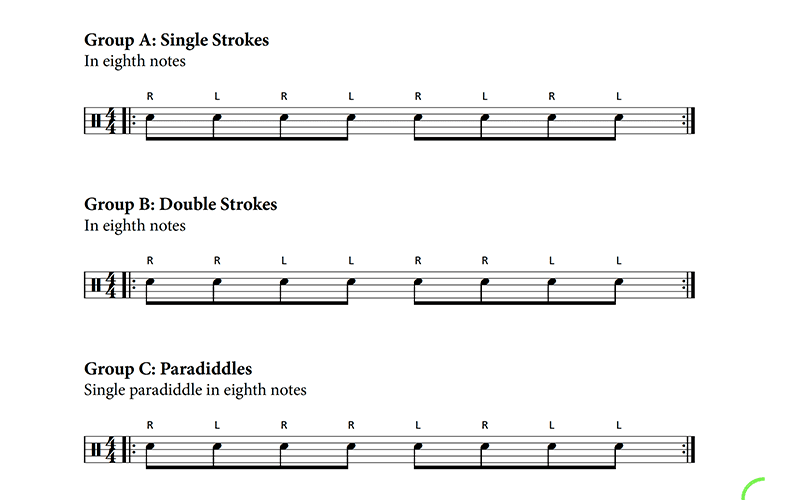
As we mentioned above, practice is the most important thing when it comes to learning an instrument, and when it comes to drum rudiments, having your muscle memory loaded with these patterns is crucial. It’s great to practice these formally – i.e. sat at your drum kit with a metronome (again start slow and keep to the metronome and get it perfect before you start increasing the speed). However, the wonderful thing about practicing rudiments is that you can do it anywhere – you can pick up a rubber practice pad pretty cheaply and you can practice your rudiments whilst watching TV or on the train or bus.
How To Read Sheet Music For The Drums
Drum music is a little different from traditional sheet music but works off a similar principle. You still have a 5 line stave and each line or gap represents a different part of the drum kit. Then, different symbols represent different ways of playing the drums. Here is a useful introduction to the basic symbols:

Finally, rhythms are represented in the same way they are in traditional sheet music – i.e. with notes such as semi-quavers, quavers, and crotchets.
Popular Drum Tabs
One of the best bits about being a drummer is that it’s much easier to play along with your favorite records and in the process of learning those songs, you improve your playing ability. In fact, Dave Grohl famously set up pillows in the formation of a drum kit before he even got his kit and played along with the likes of the Ramones and Minor Threat. Here are some of the most popular songs for beginner drummers to learn:
How To Play Don’t Fear The Reaper on Drums
The majority of Blue Oyster Cult’s classic ‘(Don’t Fear) the Reaper’ is relatively straightforward, but as the song progresses the drums become pretty complex and there is a really interesting bar of 5/4 (with an additional beat) during the drum solo and a rolling snare, kick, and crash cymbal beat in the outro which is great fun to play:
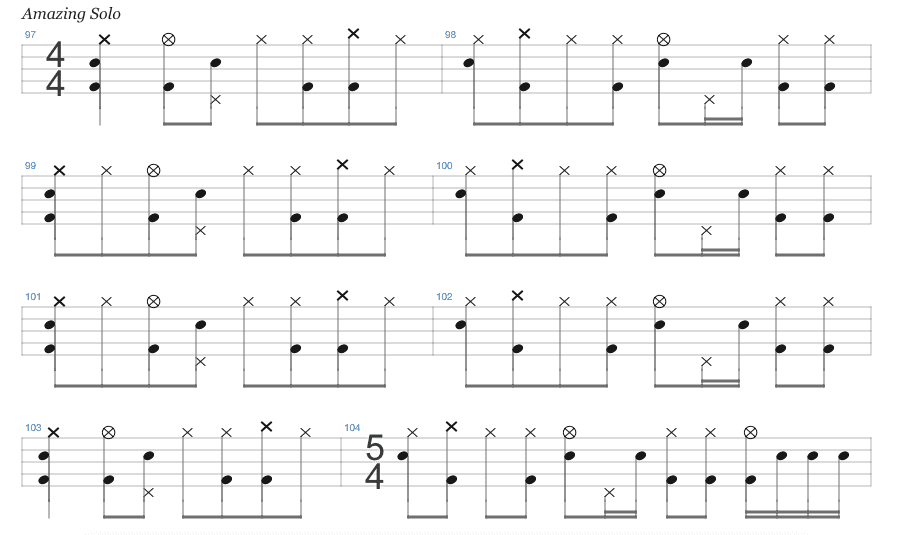

How To Play In the Air Tonight On Drums
It’s arguably one of the most famous drum fills in modern music (even before the classic chocolate advert). Phil Collins’ hit ‘In the Air Tonight’ starts with an electronic drum loop which can be played on acoustic drums:
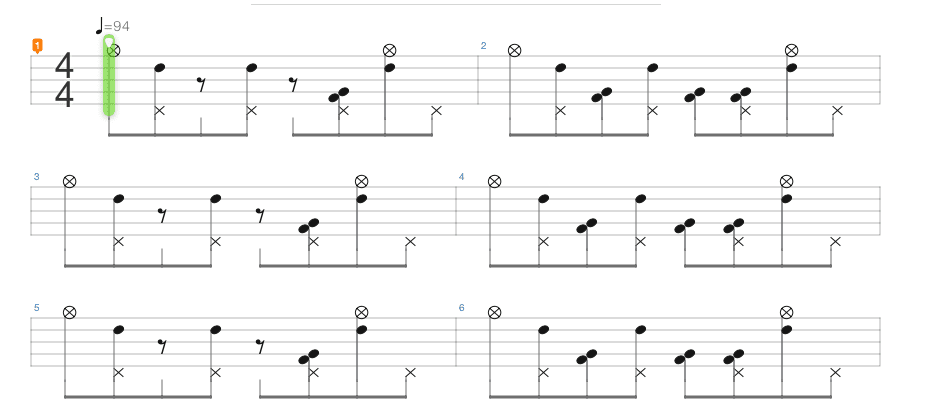
But it’s the big fill followed by the strong acoustic kit beat that really makes the song:
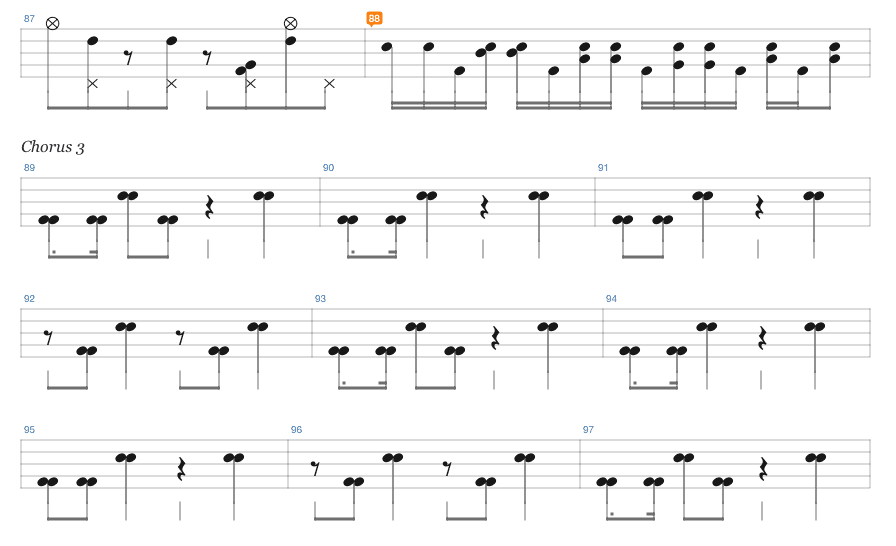
How To Play Set Fire To The Rain On Drums
The drums really drive Adele’s ‘Set Fire to the Rain’. It’s primarily a four-to-the-floor pattern with the kick drum with some accented off-beats to add motion to the song. The minimal fills also allow the piano and vocal lines to shine through. A big part of the drums in this track is their consistency – they are strong but not over-bearing and they stay in the same kind of dynamic range throughout:

How To Play Welcome To The Family On The Drums
Avenged Sevenfold’s ‘Welcome to the Family’ is an awesome drum track that opens with a massive drum fill and then alternates between a half-time pattern in the verses and a double-time pattern in the chorus which really lifts the chorus. This is a good exercise to practice for beginners as it trains you to keep the overall tempo consistent but also allows you to be busier to add excitement to a song. The bridge towards the end of the song also slips into a different time signature – 6/8 (which is 6 beats in the bar but split into 2 lilting brackets of 3. For other songs in this time signature check out The Animals ‘House of the Rising Sun’, GooGoo Dolls ‘Iris’ and Jeff Buckley ‘Hallelujah’).
One thing to note is that this track also utilizes a double bass drum pedal (so there is a pedal that sits next to the hi-hat pedal as well as the pedal in front of the bass drum and these two pedals control two beaters that hit the bass drum skin) quite heavily which is how they achieve those very quick bass drum hits. If you don’t have a bass drum pedal – those runs can be replicated on the floor tom or you can revert to a simpler bass drum pattern.
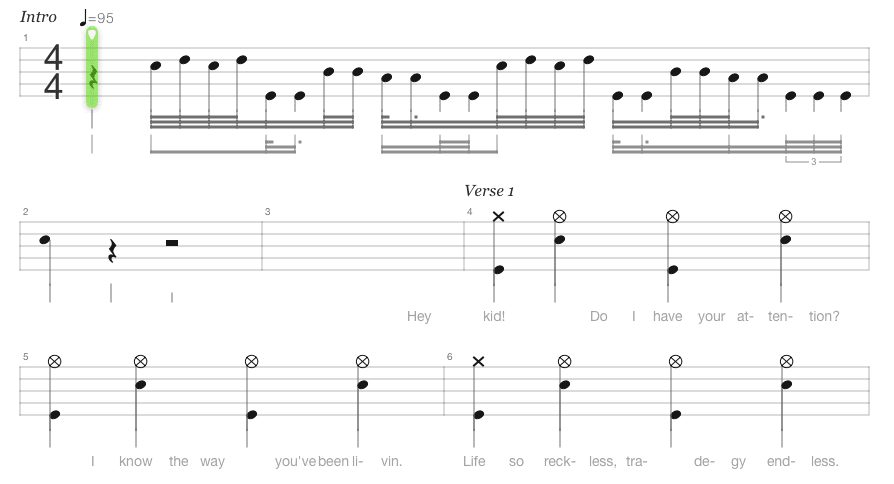
Now You Know How To Play The Drums
Well, at least you know how to get started! The drums are an awesome instrument and as we’ve said a couple of times, the real trick to being an amazing musician is practice, practice, practice. Listen to your favorite records and learn them – websites like Songsterr also have huge drum tab resources and you can even play the audio of the songs back at a slower pace which can help you get the beats right before you increase the audio to full speed.
Once you’ve got your confidence, it’s also a great idea to try to get involved with other people who are learning. Playing with other people and making music together is one of the best ways to learn how to play and it teaches you things beyond just the immediate mechanics of playing the instrument.
But most of all, have fun with it!










